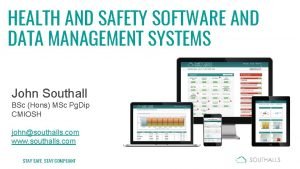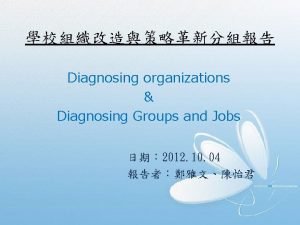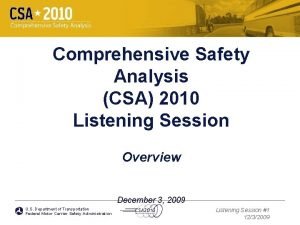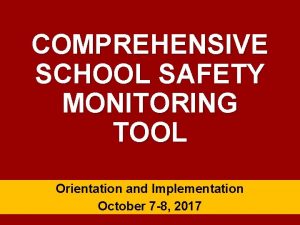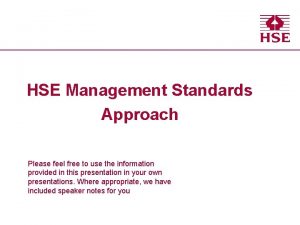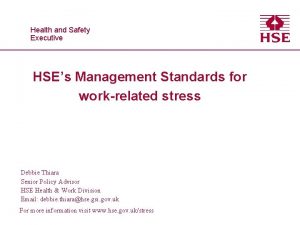Safety Health Management Systems A comprehensive safety and








- Slides: 8

Safety & Health Management Systems • A comprehensive safety and health management system that includes four essential elements and their sub-elements. These elements, when integrated into a worksite’s daily operations, can reduce the incidence and severity of illnesses and injuries: A. Management leadership and employee involvement B. Worksite analysis C. Hazard prevention and control D. Safety and health training

Barriers to the Desired Behavior Environmental: (Conditional) • • Poor Housekeeping Unsafe equipment and facility design Inadequately maintained equipment and facilities Rules, policies, and procedures that are unneeded or cumbersome Person: Behavioral: • • • Disagreement on safer practices and behaviors Lack of self-worth – an unhealthy desire to be accepted Lack of relationship and camaraderie Lack of communication and interaction skills Lack of personal responsibility (victim mentality) Lack of coach-ability Macho / hero mentality Physical impairment • • • Few consequences for lesssafe behavior Few consequences for safer behavior Emphasizing outcomes over process Condoning less safe behavior Management systems that are overly complex or unreliable Measurement and recognition systems that reward undesirable behaviors

Culture Incidents Natural Instincts Can incident free be achieved without an interdependent culture? Supervision Self Team Dependent • Independent Interdependent This Journey is reflected across all aspects of Culture From Du. Pont – Safety, Person, Behavior, Social Process, Environment, Etc…. • Safety & Health are fundamental building blocks – it is about the worth of each person

A Proven Successful Program • The Voluntary Protection Programs (VPP) promote effective worksite-based safety and health. • In the VPP, management, labor, and OSHA establish cooperative relationships at workplaces that have implemented a comprehensive safety and health management system

Key Program Elements 1. Management Commitment 2. Worker Involvement 3. Hazard Identification, including workplace inspections for violations of mandatory health and safety standards 4. Hazard Prevention and Control 5. Safety and Health Training 6. Program Evaluation

Department of Labor • The legislative underpinning for VPP is Section (2)(b)(1) of the Occupational Safety and Health Act of 1970, which declares the Congress’s intent "to assure so far as possible every working man and woman in the Nation safe and healthful working conditions and to preserve our human resources - (1) by encouraging employers and employees in their efforts to reduce the number of occupational safety and health hazards at their places of employment, and to stimulate employers and employees to institute new and to perfect existing programs for providing safe and healthful working conditions. "

Employee Involvement • Employees must be involved in the safety and health management system in at least three meaningful, constructive ways in addition to their right to report a hazard. • Avenues for employees to have input into safety and health decisions include participation in audits, accident/incident investigations, self-inspections, suggestion programs, planning, training, job hazard analyses, and appropriate safety and health committees and teams. • Employees do not meet this requirement by participating in incentive programs or simply working in a safe manner.

Desired Safety Traits To encourage desired (safer & healthier) behaviors in the workplace; specifically thorough: - Identifying critical behaviors and examples of active caring or desired behaviors - Communicating trends and issues to people to raise awareness - Developing awareness and skills in people to assist each other (coaching) - Involving people in removing barriers to the desired critical behaviors
 Southalls safety cloud
Southalls safety cloud Group level diagnostic model
Group level diagnostic model Comprehensive primary health care approach
Comprehensive primary health care approach Comprehensive safety analysis
Comprehensive safety analysis School safety monitoring
School safety monitoring Safety management system template
Safety management system template Health and safety executive 6 management standards
Health and safety executive 6 management standards Health and safety executive management standards
Health and safety executive management standards Comprehensive classroom management
Comprehensive classroom management
